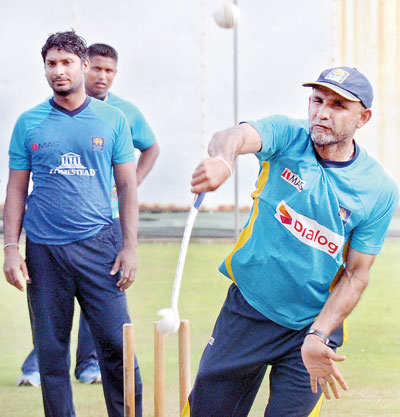Marvan it’s all yours – but there are challenges ahead
View(s):Finally the Lankans have buckled their shoes and got their gear ready to go out and play along with Marvan Atapattu who is now Sri Lanka’s Head Cricket Coach in every sense of the term.
For the past four years, he has been the batting coach, understudy and fill-in-the-blank coach running around with a hatchet hanging over his pale neck. Yet, the former Lankan captain and opening batsman took up the challenge and held his wits together to prove his credentials as a top notch coach in the world circuit.
You must be aware that being the Lankan coach carries its own merits and there are in the cricketing world many former cricketers and CV-seeker coaches who would give an arm to grab the job over here.

Atapattu working with the boys at the Premadasa nets.
The SLC hierarchy portrayed that the move got the consent of everyone in the forum who was at the executive committee who met to take this vital decision. To a great extent the statement is true. All who were present said, ‘yes’. Yet, if one claims that there was some antipathy that will be also true. Missing from the forum was two of the most powerful personalities in the Lankan cricket hierarchy in SLC President Jayantha Dharmadasa and the selection committee chairman Sanath Jayasuriya, who is a co-opted member of the executive committee. However, now that the selection has been made, Dharmadasa and Jayasuriya also must put their shoulders to the wheel and see that the right results are obtained. Winning would mean they too would get a share of the glory. At the end of the exercise, a senior insider who pushed for the Atapattu selection breathed a sigh of relief and said, “It was only a while ago that several executive committee members opposed the appointment of Atapattu, but, it ended well. They all supported the move and this augurs well for the smooth running of affairs in cricket in the country”.
Another member of the selection panel said Atapattu showed a lot of maturity during his presentation and he gave the impression that he was thorough in the subject and knew what he was talking about and, moreover, he knew what the Lankan cricket required at this juncture.
As a matter of fact, the Musings have backed the concept of a homegrown coach. The homegrown coach would always be aware of the needs of the national grid and at the same time has an idea about the backups that the local coaching structure is capable of supplying. Besides, the coach and a player could share their views and converse in a language that both understand.
Yet, at the same time a local coach could encounter 37,000ft problems. We saw it happening in Incheon, South Korea. The Sri Lanka team was almost a national team and carried one passenger along with them in their winning effort against hosts South Korea. In fact while the Lankans were at the crease he even batted ahead of hard-hitting national star Kithruwan Vithanage.
At the moment even the Under 19 team selectors are under pressure. We have seen a slow left arm spinner being included – may be out of turn.
Good if the players in question are the best that the country could offer. But, if those inclusions prevent another more deserving cricketer who could really serve the national cause, it is bad.
 These problems still have not come to the national level. But, in a country like Sri Lanka where every man’s breath is powered by that nauseating political influence, coming of such things looms in the horizon.
These problems still have not come to the national level. But, in a country like Sri Lanka where every man’s breath is powered by that nauseating political influence, coming of such things looms in the horizon.
Once being given the appointment, it was very prudent of the coach selection committee to give Atapattu the authority of selecting his team of support staff that he would be comfortable with. In a professional environment of this nature, this is a vital ingredient.
For instance when Darren Lehmann was handed over the task of taking the Australians forward, he was given the prerogative of picking his own team. So was England coach Peter Moores who even pinched the then Lankan coach Paul Farbrace — a move that paved the way for Atapattu to make his mark.
In this manner the entire coaching team is responsible for the results and a team which is working cohesively is also aware of the repercussions of a careless slip.
Prior to this when something goes wrong the SLC had the habit of picking a scapegoat and sacrificing him at the altar. That was a useless exercise. The entire coaching team has to operate as a single unit. They must know the requirements to the national grid and also work in cohesion with the national selectors and the junior teams. Atapattu being a kid from the backyard will have the advantage at this point over any foreigner.
Another huge challenge in Atapattu’s hands is to sustain a good seam team that could operate for a given period of time. What happens now is the entire fast bowling contingent that comprises bowlers like Lasith Malinga, Nuwan Pradeep, Shaminda Eranga, Nuwan Kulasekera, Suranga Lakmal and Chanaka Welagedara is injury prone. As a result, the Lankans cannot keep a rhythm in their seam attack in international cricket.
When inquired from a knowledgeable insider he said that is a two-pronged problem. On the one hand, as a result of Sri Lanka being a tropical country, the physique of the Lankan fast bowlers do not come in the same frame as bowlers who hail from the cooler climes. This part is a complete genetic fault. On the other hand it is a problem that could be addressed.
The expert pointed out the structure of the Lankan domestic tournament. The standards of the local domestic tournament have deteriorated to such levels that most of the games are played on poor wickets and the bowling at these games are dominated by spinners. In a whole game a new ball operator may get ten overs, which is insufficient to keep him in shape. However, once he is captured by the national grid and is playing cricket at international level his playing regime turns topsy-turvy. At this level the new fast bowler has to work harder and especially when it comes to a Test match, he has to bowl 20-30 overs a day, much more than he bowls in an entire domestic game.
Given the genetic attribute and the local match folly, the fast bowlers obviously cannot sustain themselves.
This is one vital area that Atapattu and his crew should look into and discuss with the decision makers who are still fighting a battle at Maitland Place to bring down the Premier League to the ideal eight clubs.
Last year they worked out a way to have eight teams in the fray in the super eights. This was the four-day final round. But, then they realised some of the good ones had missed the bus.
We take this opportunity to make a suggestion: Play all the final round games at the top venues like Pallekelle, Galle and Hambantota and R. Premadasa Stadium where there are good wickets. Then in one way they would get the exposure in playing on international wickets.
Then make provisions that a team could make use of a players (Two the most) from the teams that do not take part in the final round. Give the players who take part in the final round an enhanced emolument. In short make them want to play in this tournaent and make it attractive so that everyone would want a piece of the cake.


